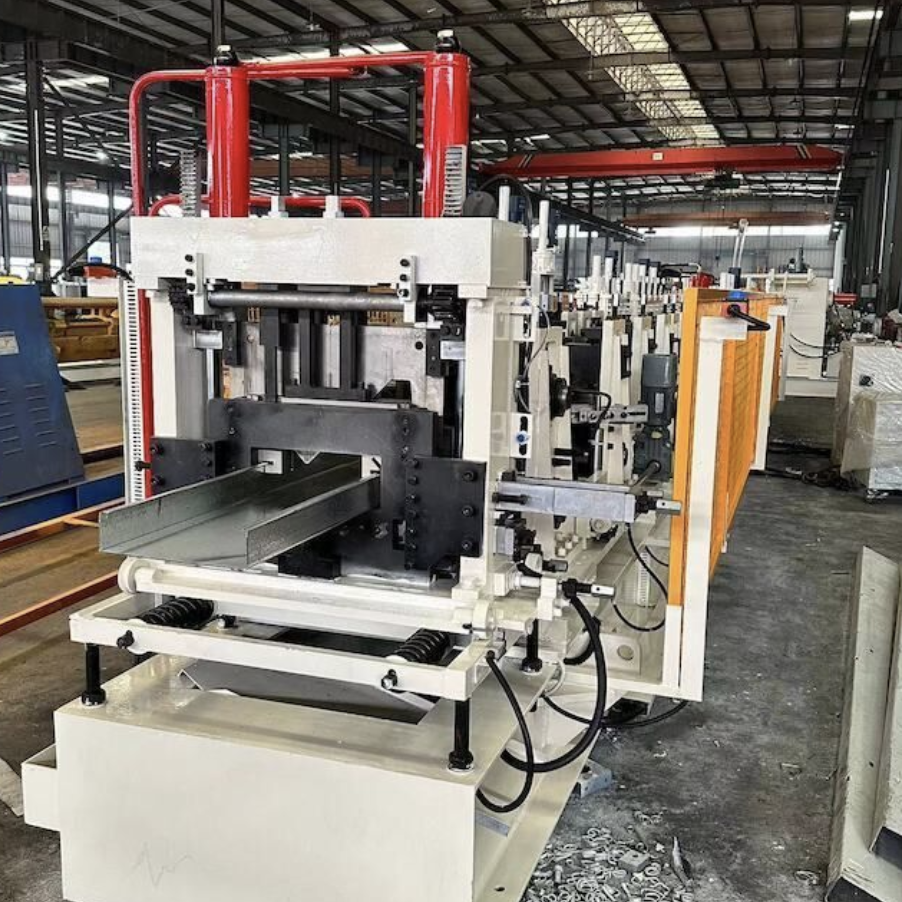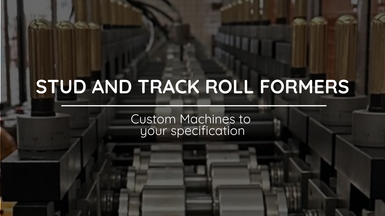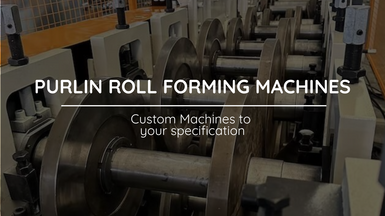
Z Purlin Machine
Here are some key features and components of a Z Purlin Roll Forming Machine:
Posted on Tuesday, November 21, 2023
A Z Purlin Roll Forming Machine is a piece of industrial equipment used in the manufacturing and construction industry to produce Z-shaped steel purlins. Purlins are horizontal structural members commonly used in the construction of buildings, providing support for the roof and walls.
The roll forming process involves feeding a coil of steel through a series of rollers and dies that gradually shape the steel into the desired Z-shaped profile. The rollers and dies are designed to bend and form the steel without causing it to deform or weaken. This process is continuous, allowing for the efficient production of long lengths of Z purlins with consistent dimensions.
Here are some key features and components of a Z Purlin Roll Forming Machine:
- Decoiler: The machine typically starts with a decoiler that holds a coil of steel. The steel coil is gradually unwound and fed into the roll forming section.
- Roll Forming Section: This is the heart of the machine, where the steel strip is gradually shaped into a Z-shaped profile through a series of rollers and dies. The exact number and arrangement of rollers and dies may vary depending on the specific design of the Z purlin.
- Cutting Mechanism: After the Z purlin profile is formed, there is usually a cutting mechanism that cuts the purlin to the desired length. This ensures that the produced purlins are of uniform size.
- Control System: Modern Z Purlin Roll Forming Machines are equipped with computerized control systems that allow operators to set and adjust various parameters, such as the purlin dimensions and production speed.
- Material Handling: Some machines may include additional features for material handling, such as automatic stacking or packaging of the finished purlins.
Z purlins are widely used in the construction industry to provide structural support for roofs and walls in buildings like warehouses, factories, and agricultural structures. They are known for their strength-to-weight ratio and ease of installation. Using a Z Purlin Roll Forming Machine can help manufacturers produce these components efficiently and cost-effectively.
The specific design and capabilities of a Z Purlin Roll Forming Machine can vary depending on the manufacturer and the requirements of the customer. These machines come in various sizes and configurations to accommodate different production needs.
Z Purlin
A Z Purlin, also known as a Zed Purlin or Z-Section, is a type of structural component used in the construction industry to provide support for the roof and walls of buildings. Z purlins are typically made from cold-formed steel and have a Z-shaped cross-section, which resembles the letter "Z" when viewed from the side. They are commonly used in industrial, commercial, and agricultural buildings due to their strength and versatility.
Here are some key characteristics and uses of Z purlins:
- Cross-Section: Z purlins have a distinctive Z-shaped cross-section, which includes two flanges (horizontal arms) connected by a vertical section in the middle. The flanges provide rigidity and support, while the vertical section helps distribute the load evenly.
- Material: Z purlins are usually made from galvanized or pre-painted cold-formed steel. This steel is chosen for its durability and resistance to corrosion.
- Support: Z purlins are used to support the roofing material (such as metal sheets) and help transfer the weight of the roof to the building's primary structural frame, which may consist of columns or rafters.
- Roofing and Cladding: Z purlins are often used in combination with other building components, such as roof and wall cladding systems. They provide a stable framework to attach these materials securely.
- Sizes and Dimensions: Z purlins come in various sizes and dimensions to accommodate different load-bearing requirements and building designs. The specific size and spacing of Z purlins depend on factors like the building's dimensions and the local building codes.
- Installation: Z purlins are installed horizontally along the length of the building's roof or walls. They are typically spaced at regular intervals, and roofing or cladding materials are attached to them using fasteners like screws or bolts.
- Advantages: Z purlins are preferred for their strength-to-weight ratio, ease of installation, and cost-effectiveness. They are lightweight yet strong, making them suitable for a wide range of construction applications.
- Versatility: Z purlins are not limited to roof applications. They can also be used in wall framing and as part of mezzanine or floor systems in some building designs.
Z purlins are an essential component in the construction of steel-framed buildings, providing structural integrity and support for the overall structure. They play a crucial role in ensuring the stability and durability of the building, especially in regions with varying weather conditions. The design and installation of Z purlins must adhere to local building codes and engineering standards to ensure the safety and integrity of the structure.
Z Purlin Sizes
The size and dimensions of Z purlins can vary widely based on the specific structural requirements of a building and the manufacturer's offerings. Z purlins come in various sizes to accommodate different load-bearing needs, building designs, and local building codes. Below are some common sizes and dimensions of Z purlins:
- Depth (Height): The depth or height of a Z purlin is measured from the top flange to the bottom flange, and it can typically range from 100mm (4 inches) to 400mm (16 inches) or more.
- Width of Flanges: The width of the flanges (the horizontal arms of the Z) is usually uniform and can range from about 40mm (1.5 inches) to 100mm (4 inches) or more, depending on the purlin size.
- Thickness: The thickness of the steel used to manufacture Z purlins can vary, with common thicknesses ranging from 1mm to 3mm or more. Thicker steel is used for larger purlins and to accommodate heavier loads.
- Lip Length: The vertical section of the Z purlin, which connects the top and bottom flanges, is referred to as the "lip." The length of the lip can vary but is typically around 15mm to 20mm.
- Hole Punching: Z purlins often come with holes or slots punched along the length of the flanges. These holes are used for attaching roofing or cladding materials and may be spaced according to industry standards or customized based on project requirements.
- Length: Z purlins are typically manufactured in standard lengths, such as 6 meters (20 feet) or 12 meters (40 feet). Longer lengths may be available for specific applications.
- Spacing: The spacing between Z purlins in a building's structure depends on factors like the design loads, roofing material, and local building codes. Common spacing intervals include 600mm (24 inches) and 900mm (36 inches) on center, but these can vary.
It's important to note that the actual dimensions and specifications of Z purlins can vary between manufacturers and regions. Therefore, when designing a building or purchasing Z purlins, it's crucial to consult with an engineer or structural designer to ensure that the selected purlin sizes and spacings meet the specific structural requirements of your project and comply with local building codes.
Additionally, the load-bearing capacity of Z purlins is determined not only by their size but also by the steel grade and thickness used in their construction. Engineering calculations are typically required to determine the appropriate size and spacing of Z purlins for a given building design and load conditions.
Z Purlin Prices
The prices of Z purlins can vary significantly based on several factors, including the size, dimensions, steel grade, thickness, and the supplier or manufacturer you choose. Additionally, market conditions, geographical location, and transportation costs can also influence the pricing of Z purlins. Here are some factors that can affect Z purlin prices:
- Size and Dimensions: Larger Z purlins typically cost more than smaller ones due to the increased amount of steel required for manufacturing.
- Steel Grade: The type of steel used can impact the price. Higher-grade steel with better strength and corrosion resistance properties may be more expensive.
- Thickness: Thicker Z purlins generally cost more than thinner ones because they use more steel material.
- Coating or Finish: If the Z purlins are coated or finished with materials such as galvanization or paint to enhance durability and corrosion resistance, this can increase the price.
- Quantity: Purchasing Z purlins in larger quantities may lead to volume discounts, reducing the unit cost.
- Supplier or Manufacturer: Prices can vary between different suppliers and manufacturers based on their pricing strategies, production efficiency, and geographical location.
- Location: The cost of transportation and logistics can impact the final price, especially if you need to ship Z purlins to a remote location.
- Market Conditions: Steel prices can fluctuate based on global and regional market conditions, supply and demand, and economic factors.
- Customization: If you require custom hole punching, special lengths, or other customization, it may affect the price.
- Additional Accessories: Some projects may require additional accessories, such as brackets or clips, which can add to the overall cost.
To get accurate pricing for Z purlins for your specific project, it's recommended to obtain quotes from multiple suppliers or manufacturers. You can contact local steel suppliers or manufacturers who specialize in construction materials to request price quotations based on your project's specifications. Be sure to provide detailed information about the size, dimensions, steel grade, and any other requirements to receive accurate quotes.
Keep in mind that steel prices can be subject to market fluctuations, so it's a good idea to monitor the market conditions and secure pricing when it aligns with your project budget and timeline. Additionally, consider working with a structural engineer or architect who can help determine the appropriate Z purlin specifications for your building project.
All our machines are all due to variations in the customer's demand, and we are always ready to assist with any issues. All machines are assembled by our expert team in Orlando, Florida. We have been leading the Roll Forming Machine market since 2009, and have great expertise, so you will be in safe hands. For further information, contact our team here.
For more Machines, browse our extensive range here
Roll Forming Machines LLC's New Factory
Posted on Sunday, March 23, 2025
We have relocated factories, which will be available for tours very soon.

Uncoiler, Decoiler and Coil Car Roll Forming Machine Accesories from Roll Forming Machines LLC
Posted on Sunday, November 24, 2024
Contact us today with your specifications for a custom Uncoiler, Decoiler or Coil Car at [email protected] or call us at (+1) (407) 859 1119

Stud and Track Roll Forming Machines from Roll Forming Machines LLC
Posted on Saturday, November 23, 2024
Contact us today with your specifications for a custom Stud and Track Machine at [email protected] or call us at (+1) (407) 859 1119

Cee and Zee Purlin Roll Forming Machines from Roll Forming Machines LLC
Posted on Saturday, November 23, 2024
Contact us today with your specifications for a custom Cee and Zee Purlin Machine at [email protected] or call us at (+1) (407) 859 1119